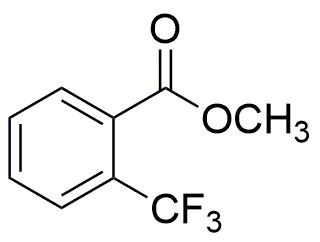Methyl 2-(trifluoromethyl)benzoate is widely utilized in research focused on:
- Pharmaceutical Development: This compound serves as an important intermediate in the synthesis of various pharmaceuticals, particularly those targeting specific biological pathways. Its unique trifluoromethyl group enhances the potency and selectivity of drug candidates.
- Agricultural Chemicals: It is used in the formulation of agrochemicals, including herbicides and insecticides, due to its ability to improve the efficacy and stability of active ingredients, making them more effective in pest control.
- Material Science: The compound is incorporated into polymer formulations to enhance thermal stability and chemical resistance, which is crucial for developing high-performance materials used in electronics and automotive applications.
- Fluorinated Compounds Research: Methyl 2-(trifluoromethyl)benzoate is a valuable building block in the synthesis of fluorinated compounds, which are essential in various applications, including refrigerants and specialty solvents.
- Analytical Chemistry: It is utilized as a standard in analytical methods, helping researchers to calibrate instruments and validate experimental results, ensuring accuracy in quantitative analysis.
General Information
Properties
Safety and Regulations
Applications
Methyl 2-(trifluoromethyl)benzoate is widely utilized in research focused on:
- Pharmaceutical Development: This compound serves as an important intermediate in the synthesis of various pharmaceuticals, particularly those targeting specific biological pathways. Its unique trifluoromethyl group enhances the potency and selectivity of drug candidates.
- Agricultural Chemicals: It is used in the formulation of agrochemicals, including herbicides and insecticides, due to its ability to improve the efficacy and stability of active ingredients, making them more effective in pest control.
- Material Science: The compound is incorporated into polymer formulations to enhance thermal stability and chemical resistance, which is crucial for developing high-performance materials used in electronics and automotive applications.
- Fluorinated Compounds Research: Methyl 2-(trifluoromethyl)benzoate is a valuable building block in the synthesis of fluorinated compounds, which are essential in various applications, including refrigerants and specialty solvents.
- Analytical Chemistry: It is utilized as a standard in analytical methods, helping researchers to calibrate instruments and validate experimental results, ensuring accuracy in quantitative analysis.
Documents
Safety Data Sheets (SDS)
The SDS provides comprehensive safety information on handling, storage, and disposal of the product.
Product Specification (PS)
The PS provides a comprehensive breakdown of the product’s properties, including chemical composition, physical state, purity, and storage requirements. It also details acceptable quality ranges and the product's intended applications.
Certificates of Analysis (COA)
Search for Certificates of Analysis (COA) by entering the products Lot Number. Lot and Batch Numbers can be found on a product’s label following the words ‘Lot’ or ‘Batch’.
*Catalog Number
*Lot Number
Certificates Of Origin (COO)
This COO confirms the country where the product was manufactured, and also details the materials and components used in it and whether it is derived from natural, synthetic, or other specific sources. This certificate may be required for customs, trade, and regulatory compliance.
*Catalog Number
*Lot Number
Safety Data Sheets (SDS)
The SDS provides comprehensive safety information on handling, storage, and disposal of the product.
DownloadProduct Specification (PS)
The PS provides a comprehensive breakdown of the product’s properties, including chemical composition, physical state, purity, and storage requirements. It also details acceptable quality ranges and the product's intended applications.
DownloadCertificates of Analysis (COA)
Search for Certificates of Analysis (COA) by entering the products Lot Number. Lot and Batch Numbers can be found on a product’s label following the words ‘Lot’ or ‘Batch’.
*Catalog Number
*Lot Number
Certificates Of Origin (COO)
This COO confirms the country where the product was manufactured, and also details the materials and components used in it and whether it is derived from natural, synthetic, or other specific sources. This certificate may be required for customs, trade, and regulatory compliance.


